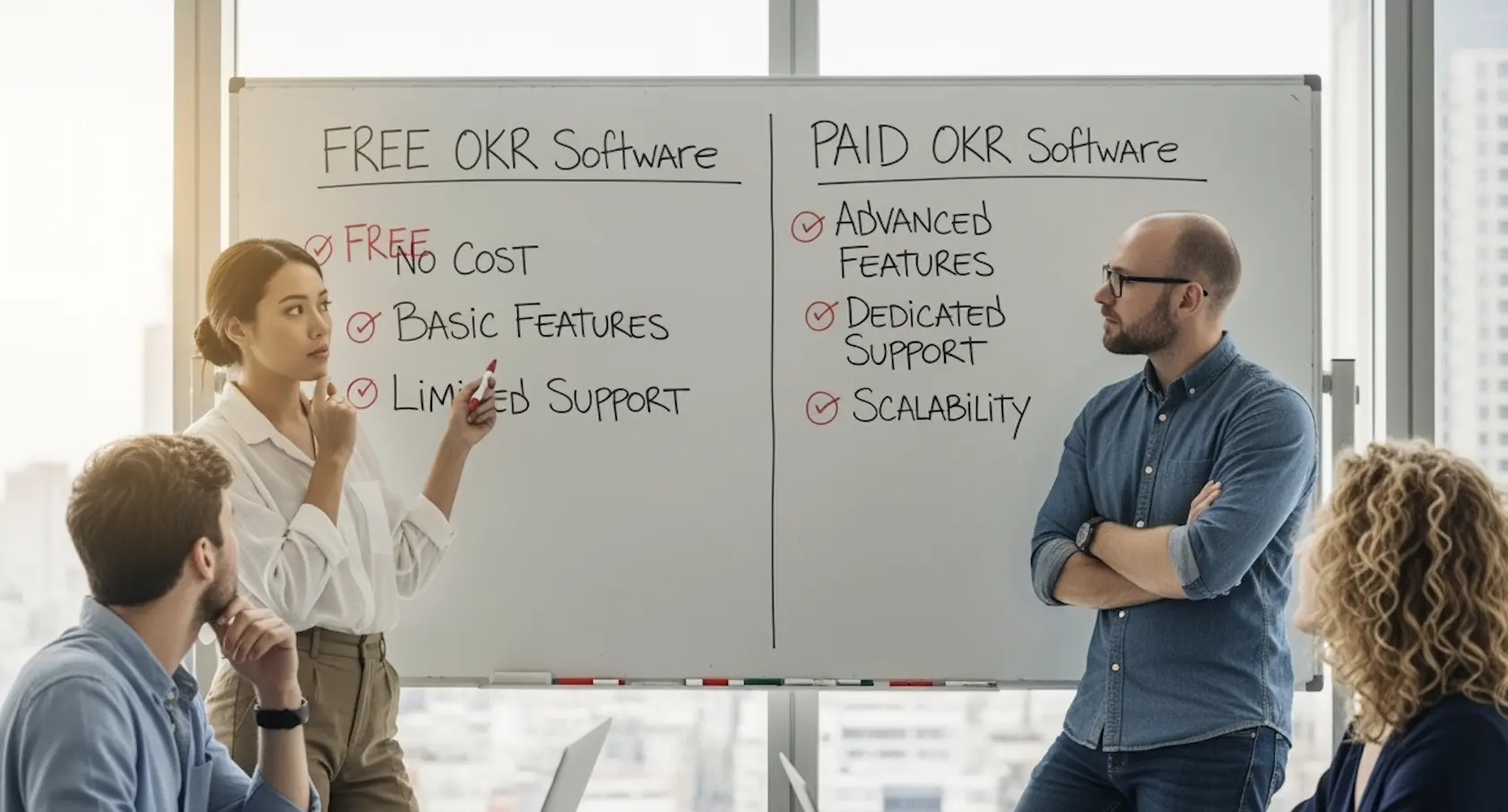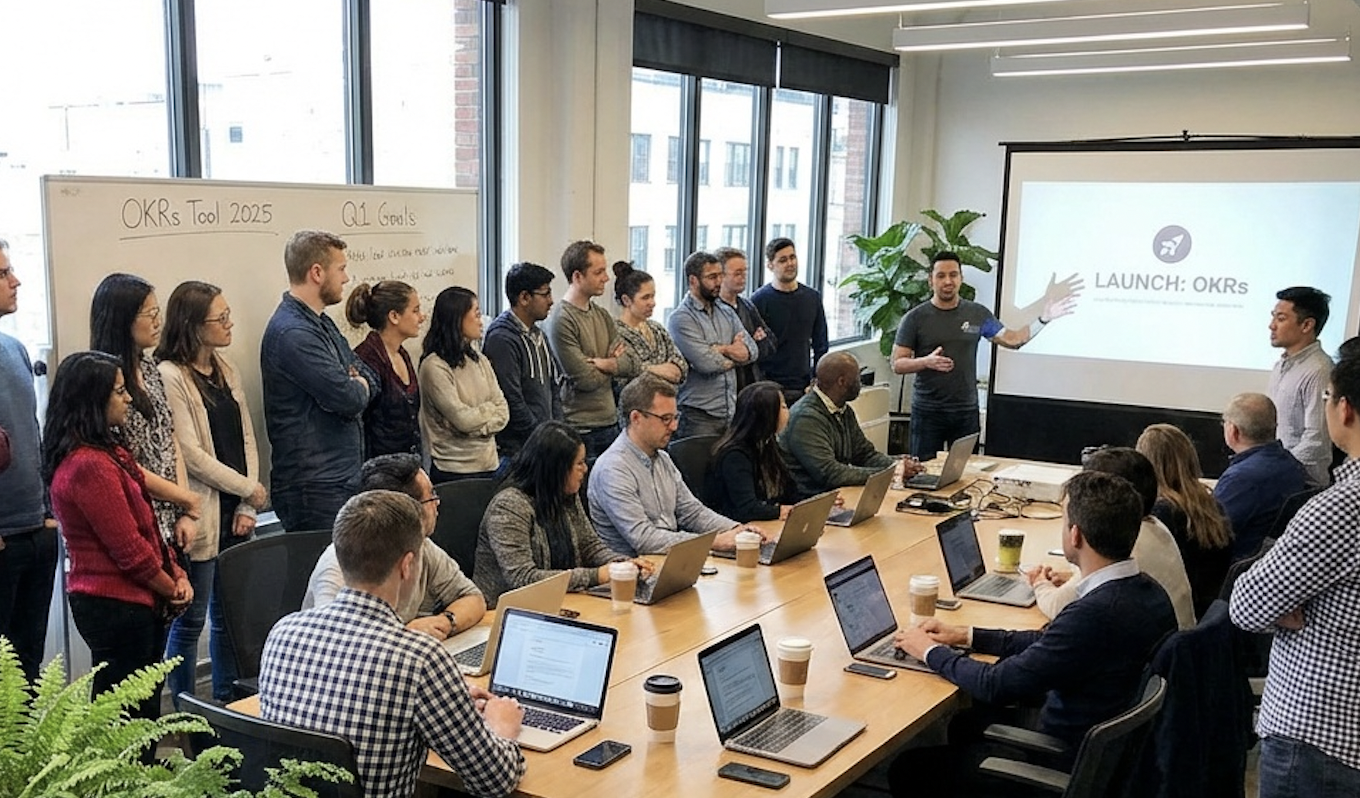Your team wants to start using OKRs.
You’ve Googled “best OKR software” and now have 12 browser tabs open.
Half of them shout “Free forever!” while the others pitch “enterprise-grade alignment” with a price tag to match.
The question isn’t just “What’s the best OKR software?” - it’s whether you should pay for it at all.
The answer?
It depends where you are in your growth, how disciplined your team is, and how much you value automation over admin work.
Let’s break it down so you can make the call without wasting budget - or ending up in a tool you’ll outgrow in three months.
The Case for Free OKR Software
If you’re in the early days, free OKR software can feel like a no-brainer - and in many cases, it is.
Why free tools can work:
- Zero cost to experiment – Learn the OKR framework without committing budget.
- Fast setup – No procurement process, no long contracts.
- Low risk – If OKRs don’t stick, you haven’t sunk money into unused seats.
But free comes with limits - and those limits matter more as you grow.
Typical free tier restrictions:
- Seat caps – Many free plans limit you to 5 users.
- Integrations – Often only basic or no integrations with Slack, Jira, Salesforce.
- Automation gaps – You’ll need to run manual check-ins and reporting.
- Data export limits – Some free plans lock you in, making migration harder.
- Support – Usually just help docs or a community forum.
Hidden Costs of “Free”
- Time tax – If you’re chasing updates manually, a founder or manager might burn 2–3 hours a week.
- Adoption drop-off – Without reminders or nudges, OKRs fade after week two.
- Silo creep – Without shared dashboards, teams lose sight of what others are working toward.
Founder example: A 7-person startup ran OKRs in an OKR template in Excel. By week 6, only 3 people were updating it. By week 12, priorities had drifted and no one could remember why certain projects were still on the list.
Bottom line: Free OKR software is perfect for testing the framework with a small, motivated team. The moment you need cross-functional visibility or automation, you’ll hit the walls fast.
The Case for Paid OKR Software
Paid plans aren’t just “the same tool, but unlocked.”
The leap to paid unlocks features that save hours every week - and keep OKRs alive when the novelty wears off.
What you typically get when you pay:
- Unlimited seats – Scale beyond the 10-person cap without extra admin.
- Automated check-ins – Weekly reminders & progress updates without chasing people.
- Deep integrations – Connect to Slack, Jira, Notion, Asana, Salesforce.
- Advanced reporting – Segment by team, track trends, share dashboards with leadership.
- Support & onboarding – Real humans who’ll help you roll out OKRs correctly.
- Security features – SOC 2, SSO, permissions - important as you grow.
The ROI Case for Paid
- Time savings – Automation can reclaim 1–2 hours per manager per week.
- Higher engagement – Check-in rates can double with reminders built into tools people already use.
- Better reporting – Investors and leadership see clean, real-time progress without manual deck-building.
Founder example: A 22-person SaaS company upgraded to a paid OKR tool. Automated Slack nudges increased check-in completion from 45% to 92%, and they spotted at-risk KRs mid-cycle instead of post-mortem.
Bottom line: If you’ve got multiple teams, remote collaboration, or execs expecting quarterly OKR updates, paid software often pays for itself in time saved and goals actually met.
The Real Tradeoffs Between Free and Paid OKR Tools
Here’s a quick, at-a-glance comparison to help you decide whether a free plan is enough for now - or if a paid tool will save you time (and headache) as you scale.
Rule of thumb: if you need automation, integrations, and clean reporting across teams, paid will pay for itself - otherwise, start free and upgrade when the limits hurt.
When to Stick with Free
- You’re <10 people
- You’re new to OKRs and just want to learn the basics
- You’re fine with manual check-ins
- You don’t need integrations or dashboards
- You’re experimenting before a bigger rollout
When Paid is Worth It
- You’re >15 people and cross-functional
- You want automated check-ins and reminders
- You need reporting for leadership/investors
- You have multiple teams or departments to align
- You can’t afford goals slipping mid-quarter
Moving from Free → Paid Without the Pain
- Audit adoption – Is your free tool already part of the weekly workflow?
- Map integrations – List the tools you want to connect (Slack, Jira, Asana, CRM).
- Define reporting needs – What does leadership actually want to see each quarter?
- Set a migration date – Avoid mid-cycle switches unless adoption is collapsing.
- Train champions – Pick 2–3 team members to model and promote the change.
Pro tip: Run the first paid cycle with overlap - keep the old tool visible but let the paid one become the primary update space.
How to Decide in Under 5 Minutes: The OKR Tool Filter
Ask yourself:
- Do we need more than 10 seats?
- Do we want automated check-ins to avoid chasing people?
- Do we need integrations with our project or CRM tools?
- Do we report OKRs to leadership or investors?
- Do we care about advanced analytics or trend data?
If you said “yes” to 3 or more → paid will likely pay for itself in saved time and higher OKR engagement.
Final Thoughts
Free OKR software is a great way to learn the ropes. Paid OKR software is a great way to scale the habit across a growing team without adding admin overhead.
The real tradeoff?
Control and automation vs. manual tracking and limits.
Pick the one that fits your stage today - and be ready to upgrade when the bottlenecks start showing.






